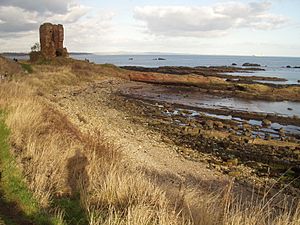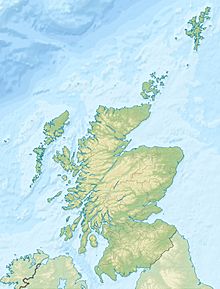Seafield Tower facts for kids
Quick facts for kids Seafield Tower |
|
|---|---|
| Fife, Scotland | |
 |
|
| Coordinates | 56°04′59″N 3°09′36″W / 56.08295°N 3.16011°W |
| Type | Tower-house and courtyard |
| Site information | |
| Condition | ruined |
| Site history | |
| Built | c. 1542 |
| Built by | John Moultray |
| In use | until 1733 |
| Materials | Sandstone |
Seafield Tower is an old, ruined castle found on the coast of the North Sea in Fife, Scotland. People also call this historic building a 'Medieval Tower House'. It's a cool spot to visit if you're walking along the Fife Coastal Path.
Contents
A Look Back: Seafield Tower's History
When Was Seafield Tower Built?
Seafield Tower was built a long time ago, around the year 1542. It sits between the towns of Kinghorn and Kirkcaldy in Fife, Scotland.
Who Owned Seafield Tower?
The land where Seafield Tower stands was first given to a person named Robert Multrare in 1443. This gift came from James II of Scotland, who was the king at that time. The Multrare family, whose name later became Moultrie, owned the land and the tower for many years.
In 1631, the Multrare family sold the land to James Law. He was an important person known as the Archbishop of Glasgow. After James Law passed away in 1632, the tower was owned by different families over time. The last known owners were the Methven family. The very last owner, Methven of Raith, left the tower in 1733. After that, it slowly fell apart and became the ruin we see today.
What Did Seafield Tower Look Like?
When it was first built, Seafield Tower was thought to be five stories tall. Its walls were very thick, about 5 feet (1.5 m) thick! The inside rooms were about 20 feet 2 inches (6.1 m) long and 14 feet 4 inches (4.4 m) wide. The tower was shaped like an 'L' and built using local red sandstone.
The ground floor of the tower likely had a strong, arched storage area. The first floor was probably home to a large room called the Great Hall. This was where important meetings and feasts would happen. The floors above that would have been where the lord of the tower lived.
Other Buildings Around the Tower
An old map from 1774 shows that there were other buildings near the tower. These included a bakery, a brewery, and stables for horses. These buildings were located in an enclosed area to the west of the tower. Usually, a strong wall called a barmkin would protect these buildings. Sadly, any signs of this wall have been lost over time because of coastal erosion. This is when the sea slowly wears away the land.
Seafield Tower Today
Today, Seafield Tower is mostly just an empty shell. It is in very poor condition. After a big storm in January 2013, a large part of the tower's northwest corner fell down.
Seafield Tower: A Protected Monument
Seafield Tower is an important historical site. Because of its history, it has special protection.
From 1973 to 2015, the tower was called a Category B listed building by Historic Scotland. This meant it was a building of special architectural or historic interest. In 2015, it was no longer listed as Category B. This is because, since 2003, the tower and the land around it have been protected together as one combined scheduled monument. A scheduled monument is a nationally important archaeological site or historic building. The area around the tower had actually been protected since 1937.


